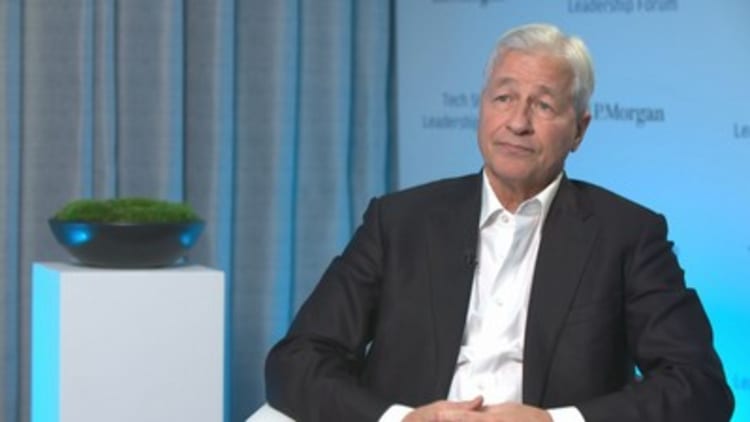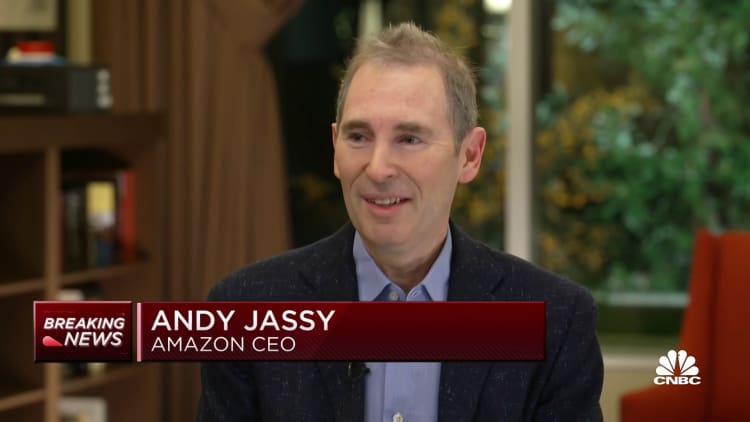Andy Jassy, CEO of Amazon and then CEO of Amazon Web Services, speaks at the WSJD Live conference in Laguna Beach, California, October 25, 2016.
Mike Blake | Reuters
Throughout its first 25 years as a public company, Amazon has operated under a singular mantra, often to the chagrin of Wall Street: growth is more important than profits.
Founder Jeff Bezos laid out that strategy in his first investor letter in 1997.
“We will continue to make investment decisions in light of long-term market leadership considerations rather than short-term profitability considerations or short-term Wall Street reactions,” Bezos wrote.
But with three-quarters of 2022 in the books, it’s clear that the tone has changed. Andy Jassy, who took over as CEO in July 2021, has been in cost-cutting mode to preserve cash as Amazon confronts slowing sales and a gloomy global economy. The stock is down 33% for the year, more than the 25% drop in the S&P 500 and is on pace for its worst year since 2008.
The wave of frugality is unfamiliar to Amazon investors and an employee base that swelled to 1.6 million last year from under 650,000 in 2018. In recent months, Amazon has shut down its telehealth service, discontinued a quirky, video-calling projector for kids, closed all but one of its U.S. call centers, axed its roving delivery robot, shuttered underperforming brick-and-mortar chains, and is closing, canceling or delaying some new warehouse locations. Amazon has also considered drastically reducing the size of its secretive skunkworks lab Grand Challenge, Insider reported.
On the recruiting front, Amazon is freezing hiring for corporate roles in its retail business. And last month’s annual hardware event, which normally showcases a roster of gadgets and robots that may or may not still be around in a year or two, was noticeably constrained compared to prior launch events.
“If we look at everything collectively, Amazon seems to care a little more about margin than they have historically,” said Tom Forte, an analyst at D.A. Davidson who recommends buying the stock.
Jassy addressed the recent efforts to rein in costs at Amazon’s global all-hands meeting on Monday.
“Good companies that last a long period of time, who are thinking about the long term, always have this push and pull,” Jassy said at the meeting, according to excerpts shared with CNBC. “There are some years where they’re expanding really broadly. Some years where they’re checking in and working on profitability, tightening the belt a little bit. And sometimes when you have multiple businesses like we do at Amazon, some businesses are expanding at the same time that others are checking in.”
Amazon is far from alone in feeling the pinch. Fellow tech giants Meta and Alphabet have also been cutting costs to reflect a challenging macro environment and a dramatic slowdown after a decade of consistent growth. Companies across the tech sector have announced layoffs and hiring freezes or have lowered their hiring targets for the coming months.
Not that Amazon has put the brakes on all new spending. The company has been on a buying spree in recent months, agreeing to acquire primary care provider One Medical for $3.9 billion, Roomba maker iRobot for $1.7 billion and Belgian warehouse robotics company Cloostermans for an undisclosed amount. The company also said it would spend about $1 billion over the next year on wage increases and expanded benefits for front-line workers, and it has plans to hire 150,000 employees to help manage the holiday rush.
“We have an enormous amount of things that we’re investing in and that will continue,” Jassy said at the meeting, referencing Alexa, Prime Video and grocery as examples of some areas where Amazon continues to spend. “The trick for us during this time is just to balance those long-term investments and bets and customer experiences that we believe are the future of the company, along with really focusing on delivering along the way.”
The recent trend of belt-tightening has raised a longer-term question because it’s coincided with the company’s first ever change in leadership at the top after Bezos’ departure. The change on Jassy’s watch has prompted some analysts and former employees to wonder whether there’s a permanent shift in strategy underway or a temporary reset reflecting economic uncertainty.
Bezos built a reputation as a fearless entrepreneur willing to make big risky bets that could require hefty investment and may not generate meaningful revenue for years, if ever. No wager was bigger than Amazon Web Services, the cloud-computing unit that Amazon launched in 2006 and that Jassy led until his promotion last year.
More recent projects under Bezos included self-driving robotaxis, cashierless stores and delivery drones, all in pursuit of making life easier for customers.
Bezos ultimately axed plenty of products that didn’t pan out after launch. One of the most infamous examples is the Fire Phone, Amazon’s first smartphone that was discontinued in 2015, a year after its debut. Other endeavors with a short shelf life included a restaurant delivery service, social media feed, a device designed to replenish items with one click, a ticketing service, an auction site and an online wine store.
“They’re completely unafraid to kill something that’s not working,” said Craig Berman, a former Amazon vice president for global communications. “That’s never been a problem for them in the past.”
As the head of AWS, Jassy was at the center of Amazon’s profit engine, which gave the company the fuel to invest elsewhere. But since taking over as CEO of the parent company, Jassy has had to navigate the biggest jump in inflation in 40 years, supply shortages and an aggressive organized labor push that’s challenged the company’s long-standing anti-union stance.
More cuts may be coming
He’s putting in place cuts at a time when Wall Street has little appetite for the kind of experimental high-risk investing that defined the Bezos era. In July, Amazon reported its third straight quarter of single-digit revenue growth, largely due to weakening demand in its core online stores business.
Jassy is also working to dial back Amazon’s Covid expansion, which left it saddled with too much warehouse space and too many staffers. Amazon reduced its headcount by 99,000 people to 1.52 million employees at the end of the second quarter after almost doubling in size during the pandemic.
More slashing could be on the docket.
Amazon is in the middle of its annual planning process, which occurs in two phases, referred to as “OP-1” and “OP-2.” OP stands for “Operating Plan.” Former Amazon employees Colin Bryar and Bill Carr wrote about the process in their 2021 book, “Working Backwards: Insights, Stories, and Secrets from Inside Amazon.”
OP-1 typically begins during the summer and involves months of preparation and planning. Each team puts together a proposal outlining key initiatives for the upcoming year, including any requests for funding or new hires. OP-1 documents are typically submitted before the start of the fourth quarter, which covers the critical holiday shopping period, and are reviewed by Amazon’s senior leadership team, called the S-Team.
The second phase, OP-2, takes place in January. That’s when teams finalize their annual plans, potentially tweaking them depending on fourth-quarter performance.

With the risk of recession on the rise, Amazon could be looking at further reductions in its investments if the holiday quarter is weaker than anticipated, a former Amazon manager told CNBC. Another ex-manager from the company said Jassy may be more deliberate about what spending requests he approves as a signal for where Amazon plans to focus given the uncertainty. Both former employees requested anonymity in order to speak candidly.
An Amazon spokesperson said in a statement that the company continuously evaluates “the progress and potential of our products and services to deliver customer value, and we regularly make adjustments based on those assessments.”
Layoffs unlikely
Still, don’t expect to see mass layoffs from Amazon even as the company curtails spending, or pulls the plug on some projects.
When Amazon winds down a business, it typically offers employees the chance to apply for a job elsewhere in the company, several former employees told CNBC. They’re usually given a window of one to three months to look for another role and have the opportunity to meet with various business leaders during that time.
“Amazon is not going to let good talent walk out the door,” said Andrea Leigh, a former Amazon executive who spent almost a decade at the company across a number of different businesses.
There can still be job losses. After Amazon announced it was winding down its telehealth service Amazon Care, it said 159 employees could be laid off. Another 236 employees will be let go from Care Medical, an independent company that was contracted by Amazon to treat Care patients.
One new invention that Jassy may be counting on to goose revenue is a second Prime Day sale. Taking place Tuesday and Wednesday of this week, it’s the first time Amazon has had two of its discount bonanzas in the same year since it launched Prime Day in 2015.
Ahead of its third-quarter earnings report later this month, the multiday shopping event may provide Amazon with an early sneak peek at what’s coming in 2023.



